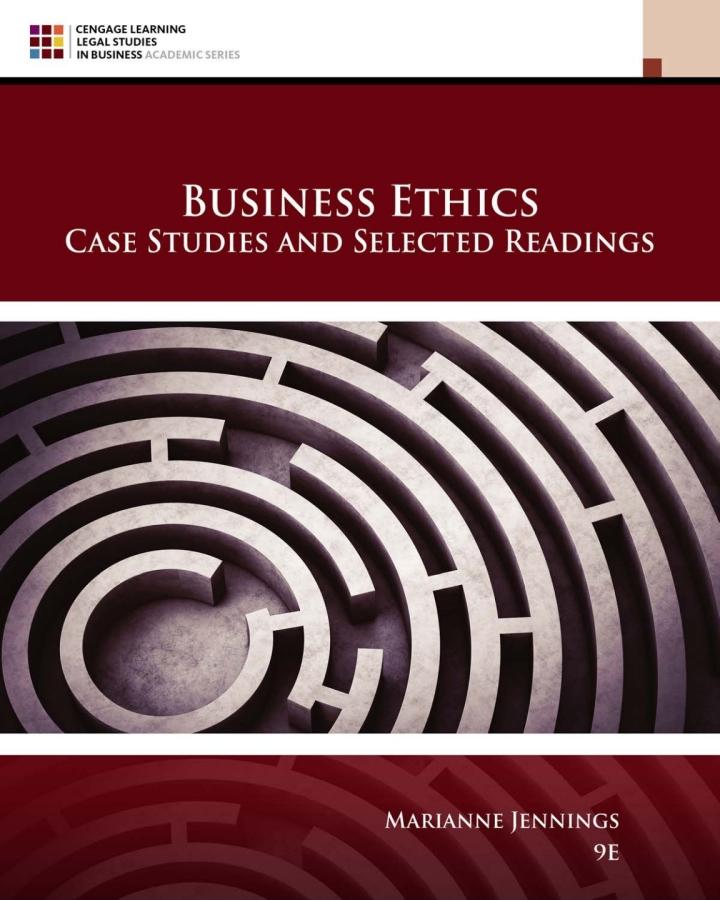In Scott Smiths book A Simple Plan, the lead character, Hank; his brother, Jacob; and a friend,
Question:
In Scott Smith’s book A Simple Plan, the lead character, Hank; his brother, Jacob; and a friend, Lou come upon a small plane buried in the rural snowdrifts of Ohio. Upon opening the plane's door, they find the decomposing body of the pilot and a duffel bag full of \($100\) bills in \($10\),000-dollar packets—\($3\) million total. Initially, Hank tells his brother and Lou not to touch the money so that the police can conduct a proper investigation, but then a plan is hatched. Lou and Jacob want to keep one packet of the money and ask Hank what's wrong with doing that. Hank scolds them and says, “For starters, it’s stealing.” Hank reminds them that with so much money involved, someone would be looking for it and would know that they had taken a packet. Hank also reminds them that even if he didn't take a packet, he would be an accomplice if Jacob and Lou did.
Lou then proposes a solution: take it all. Hank wisely warns the two that they could not spend it because everyone in their small town would know. So, Lou proposes a “simple plan.’ They will sit on the money for a while, and when the investigation is over and things have cooled down, they can move away and live on their shares of the money. Again, Hank reminds them that it is stealing. But Jacob calls it by a different name: lost treasure. Hank succumbs. Such an easy thing, a simple plan.
But the initial decision was flawed. Whatever its soft label, their decision to walk away with the duffel bag was indeed taking something that did not belong to them. From there, the characters begin a game of whack-a-mole. With each twist and turn, they have to cross another line to cover up their seizure of the duffel bag. There is a lie to the sheriff and the problem of a neighbor seeing them near the plane, and more problems come at them each day. Each new problem requires a resolution that involves more dastardly choices. The characters keep slipping, eventually committing murder.
Once you step outside those ethical norms, you do keep going. The proverbial slope becomes more slippery. Professor Dan Ariely of Duke University found that folks who knowingly wore fake designer sunglasses were more than twice as likely to cheat on an unrelated task given to them than those who were not wearing the fake sunglasses.” Once we have made peace with trademark infringement, we are willing to cross other lines. We just get comfortable with each step.
In a profile of the cheating scandal involving bogus courses at the University of North Carolina, also known as UNC, a Sports Illustrated profile described UNC’s special admits committee, a process used by many universities to admit students with talent in art or music but who did not have the academic credentials. At UNC, of the 32 special admits allotted each year, only a dozen were for the artistically gifted with the remainder going to athletes.
A vice chancellor explained how the special admits committee process deteriorated, “Every time you thought you had seen a too-marginal case, they'd give you a new excuse: This guy can make it.”* A professor who sat on the committee and voted in the “no” minority on many of the athletes expressed, “To this day I regret that I didn't blow the whistle right then and there.””’ His regret comes because once the committee made those decisions, they had athletes they needed who simply could not perform academically. They had to find a way to keep them academically qualified. While many strategies were used, the university eventually devolved into creating nonexistent courses in which the student-athletes earned passing grades for courses that never met and had no content. No one woke up one day at UNC and said, “Fake courses! That’s the way to get and keep talented athletes!” There was a slow progression of moving lines and increasing tolerance until the NCAA investigation that resulted in headlines, sanctions, and a complete revamping of standards and structures at the university........................
Discussion Questions 1. Marilee Jones, the former dean of admissions of When Ms. Jones arrived at MIT for her entrythe Massachusetts Institute of Technology (MIT), resigned after 28 years as an administrator in the admissions office. The dean for undergraduate education received information questioning Ms. Jones's academic credentials. Her résumé, used when she was hired by MIT, indicated that she had degrees from Albany Medical College, Union College, and Rensselaer Polytechnic Institute. In fact, she had no degrees from any of these schools or from anywhere else. She had attended Rensselaer Polytechnic as a part-time nonmatriculated student during the 1974—
1975 school year, but the other institutions had no record of any attendance at their schools.
level position in 1979, a degree was probably not required. However, she did progress through the ranks of the admissions office, and in 1997, she was appointed dean of admissions. She later explained that she'd wanted to disclose her lack of degrees at that point but that she had gone on for so long that she did not know how to come clean with the truth.
Point to the initial decision, why it was flawed, why Ms. Jones made that decision, and what had to be done after that as a result of that choice.
2.Can you list some lines for your credo that you can glean from A Simple Plan and Ms. Jones's experience?
Step by Step Answer:

Business Ethics Case Studies And Selected Readings
ISBN: 9780357453865
9th Edition
Authors: Marianne M. Jennings





